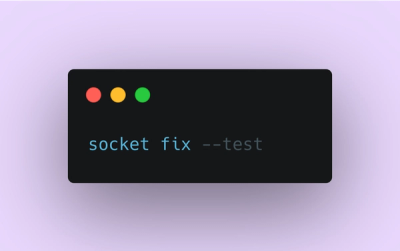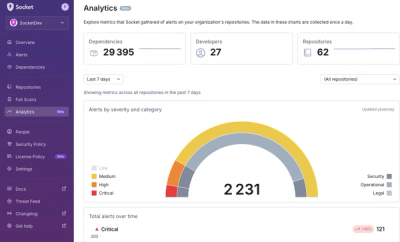
Product
Introducing Socket Fix for Safe, Automated Dependency Upgrades
Automatically fix and test dependency updates with socket fix—a new CLI tool that turns CVE alerts into safe, automated upgrades.
@azure/storage-blob
Advanced tools
The @azure/storage-blob npm package is designed for working with Azure Blob Storage. It provides a comprehensive set of features to interact with Azure Blob Storage, including uploading and downloading blobs, managing containers, and handling blob metadata and properties. This package is part of the Azure SDK for JavaScript.
Uploading blobs
This code sample demonstrates how to upload data to a blob in Azure Blob Storage. It involves creating a BlobServiceClient, getting a reference to a container, and then uploading data to a blob within that container.
const { BlobServiceClient } = require('@azure/storage-blob');
const blobServiceClient = BlobServiceClient.fromConnectionString(process.env.AZURE_STORAGE_CONNECTION_STRING);
const containerClient = blobServiceClient.getContainerClient('my-container');
const blockBlobClient = containerClient.getBlockBlobClient('my-blob');
await blockBlobClient.upload(data, data.length);Downloading blobs
This code sample shows how to download the content of a blob. It involves creating a BlobServiceClient, getting a container client, and then downloading the blob's content using the block blob client.
const { BlobServiceClient } = require('@azure/storage-blob');
const blobServiceClient = BlobServiceClient.fromConnectionString(process.env.AZURE_STORAGE_CONNECTION_STRING);
const containerClient = blobServiceClient.getContainerClient('my-container');
const blockBlobClient = containerClient.getBlockBlobClient('my-blob');
const downloadBlockBlobResponse = await blockBlobClient.download(0);
const downloadedContent = await streamToString(downloadBlockBlobResponse.readableStreamBody);Listing blobs in a container
This example demonstrates how to list all blobs in a specific container. It involves creating a BlobServiceClient, obtaining a container client, and iterating over the blobs in the container, printing out their names.
const { BlobServiceClient } = require('@azure/storage-blob');
const blobServiceClient = BlobServiceClient.fromConnectionString(process.env.AZURE_STORAGE_CONNECTION_STRING);
const containerClient = blobServiceClient.getContainerClient('my-container');
for await (const blob of containerClient.listBlobsFlat()) {
console.log(`Blob name: ${blob.name}`);
}The AWS SDK for JavaScript allows developers to interact with AWS services, including Amazon S3 for object storage, which is similar to Azure Blob Storage. Compared to @azure/storage-blob, aws-sdk supports a broader range of AWS services but is specific to AWS infrastructure.
This project provides a SDK in JavaScript that makes it easy to consume Microsoft Azure Storage services.
Please note that this version of the SDK is a compete overhaul of the current Azure Storage SDK for Node.js and JavaScript in Browsers, and is based on the new Storage SDK architecture.
This SDK is compatible with Node.js and browsers, and validated against LTS Node.js versions (>=6.5) and latest versions of Chrome, Firefox and Edge.
You need polyfills to make this library work with IE11. The easiest way is to use @babel/polyfill, or polyfill service. Or you can load separate polyfills for missed ES feature(s). This library depends on following ES6 features which need external polyfills loaded.
PromiseString.prototype.startsWithString.prototype.endsWithString.prototype.repeatString.prototype.includesThere are differences between Node.js and browsers runtime. When getting start with this SDK, pay attention to APIs or classes marked with "ONLY AVAILABLE IN NODE.JS RUNTIME" or "ONLY AVAILABLE IN BROWSERS".
SharedKeyCredentialgenerateAccountSASQueryParameters()generateBlobSASQueryParameters()uploadFileToBlockBlob()uploadStreamToBlockBlob()downloadBlobToBuffer()uploadBrowserDataToBlockBlob()The preferred way to install the Azure Storage SDK for JavaScript is to use the npm package manager. Simply type the following into a terminal window:
npm install @azure/storage-blob
In your TypeScript or JavaScript file, import via following:
import * as Azure from "@azure/storage-blob";
Or
const Azure = require("@azure/storage-blob");
To use the SDK with JS bundle in the browsers, simply add a script tag to your HTML pages pointing to the downloaded JS bundle file(s):
<script src="https://mydomain/azure-storage.blob.min.js"></script>
The JS bundled file is compatible with UMD standard, if no module system found, following global variable(s) will be exported:
azblobDownload latest released JS bundles from links in the GitHub release page. Or from following links directly:
You need to set up Cross-Origin Resource Sharing (CORS) rules for your storage account if you need to develop for browsers. Go to Azure portal and Azure Storage Explorer, find your storage account, create new CORS rules for blob/queue/file/table service(s).
For example, you can create following CORS settings for debugging. But please customize the settings carefully according to your requirements in production environment.
The Azure Storage SDK for JavaScript provides low-level and high-level APIs.
ServiceURL, ContainerURL and BlobURL objects provide the low-level API functionality and map one-to-one to the Azure Storage Blob REST APIs.
The high-level APIs provide convenience abstractions such as uploading a large stream to a block blob (using multiple PutBlock requests).
const {
Aborter,
BlobURL,
BlockBlobURL,
ContainerURL,
ServiceURL,
StorageURL,
SharedKeyCredential,
AnonymousCredential,
TokenCredential
} = require("@azure/storage-blob");
async function main() {
// Enter your storage account name and shared key
const account = "account";
const accountKey = "accountkey";
// Use SharedKeyCredential with storage account and account key
const sharedKeyCredential = new SharedKeyCredential(account, accountKey);
// Use TokenCredential with OAuth token
const tokenCredential = new TokenCredential("token");
tokenCredential.token = "renewedToken";
// Use AnonymousCredential when url already includes a SAS signature
const anonymousCredential = new AnonymousCredential();
// Use sharedKeyCredential, tokenCredential or tokenCredential to create a pipeline
const pipeline = StorageURL.newPipeline(sharedKeyCredential);
// List containers
const serviceURL = new ServiceURL(
// When using AnonymousCredential, following url should include a valid SAS or support public access
`https://${account}.blob.core.windows.net`,
pipeline
);
let marker;
do {
const listContainersResponse = await serviceURL.listContainersSegment(
Aborter.none,
marker
);
marker = listContainersResponse.marker;
for (const container of listContainersResponse.containerItems) {
console.log(`Container: ${container.name}`);
}
} while (marker);
// Create a container
const containerName = `newcontainer${new Date().getTime()}`;
const containerURL = ContainerURL.fromServiceURL(serviceURL, containerName);
const createContainerResponse = await containerURL.create(Aborter.none);
console.log(
`Create container ${containerName} successfully`,
createContainerResponse.requestId
);
// Create a blob
const content = "hello";
const blobName = "newblob" + new Date().getTime();
const blobURL = BlobURL.fromContainerURL(containerURL, blobName);
const blockBlobURL = BlockBlobURL.fromBlobURL(blobURL);
const uploadBlobResponse = await blockBlobURL.upload(
Aborter.none,
content,
content.length
);
console.log(
`Upload block blob ${blobName} successfully`,
uploadBlobResponse.requestId
);
// List blobs
do {
const listBlobsResponse = await containerURL.listBlobFlatSegment(
Aborter.none,
marker
);
marker = listBlobsResponse.marker;
for (const blob of listBlobsResponse.segment.blobItems) {
console.log(`Blob: ${blob.name}`);
}
} while (marker);
// Get blob content from position 0 to the end
// In Node.js, get downloaded data by accessing downloadBlockBlobResponse.readableStreamBody
// In browsers, get downloaded data by accessing downloadBlockBlobResponse.blobBody
const downloadBlockBlobResponse = await blobURL.download(Aborter.none, 0);
console.log(
"Downloaded blob content",
downloadBlockBlobResponse.readableStreamBody.read(content.length).toString()
);
// Delete container
await containerURL.delete(Aborter.none);
console.log("deleted container");
}
// An async method returns a Promise object, which is compatible with then().catch() coding style.
main()
.then(() => {
console.log("Successfully executed sample.");
})
.catch(err => {
console.log(err.message);
});
This project is licensed under MIT.
This project welcomes contributions and suggestions. Most contributions require you to agree to a Contributor License Agreement (CLA) declaring that you have the right to, and actually do, grant us the rights to use your contribution. For details, visit https://cla.microsoft.com.
When you submit a pull request, a CLA-bot will automatically determine whether you need to provide a CLA and decorate the PR appropriately (e.g., label, comment). Simply follow the instructions provided by the bot. You will only need to do this once across all repos using our CLA.
This project has adopted the Microsoft Open Source Code of Conduct. For more information see the Code of Conduct FAQ or contact opencode@microsoft.com with any additional questions or comments.
FAQs
Microsoft Azure Storage SDK for JavaScript - Blob
The npm package @azure/storage-blob receives a total of 2,042,432 weekly downloads. As such, @azure/storage-blob popularity was classified as popular.
We found that @azure/storage-blob demonstrated a healthy version release cadence and project activity because the last version was released less than a year ago. It has 0 open source maintainers collaborating on the project.
Did you know?

Socket for GitHub automatically highlights issues in each pull request and monitors the health of all your open source dependencies. Discover the contents of your packages and block harmful activity before you install or update your dependencies.

Product
Automatically fix and test dependency updates with socket fix—a new CLI tool that turns CVE alerts into safe, automated upgrades.

Security News
CISA denies CVE funding issues amid backlash over a new CVE foundation formed by board members, raising concerns about transparency and program governance.

Product
We’re excited to announce a powerful new capability in Socket: historical data and enhanced analytics.